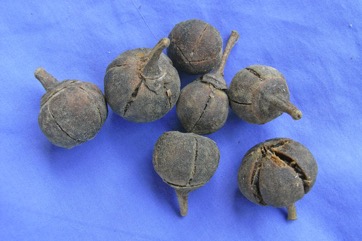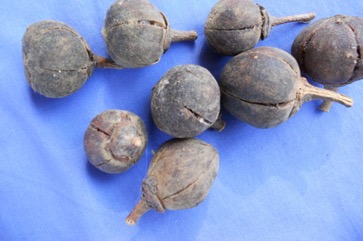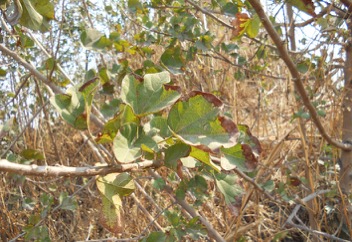Chewing gum tree

It is a tropical plant. It grows in the lowlands. It grows in most types of woodland from sea level to 1700 m altitude in South Africa. It grows in savannah country. It grows in hot arid places. It grows in areas with an annual rainfall between 255-1,270 mm. In Zimbabwe it is mostly in areas with an annual rainfall between 750-900 mm per year. It can grow in arid places. It often grows in termite mounds. It grows in Miombo woodland in Africa.
Also known as:
Azanza, Emotoo, Goron tula, Intchavana, Intchavana, Itobgwe, Kitotoo, Maneko, Matohwe, M'fono, Mhlaguhlagu, Mnduwe, Molee, Monego, Moroja, Morojwa, Mtobo, Mtowo, mu-Tuu, Mufufuma, Mugurura, Mukole, Mukukuma, Munogotogiwa, Muraurau, Mutoba, Mutobge, Mutogwe, Mutohwe, Mutongoe, Mutoo, Mutowe, Nakhgar, Ntobo, Quarters, Rhodesian tree hibiscus, Shot-apple, Snot apple, Snotappel, Tlaghay, Tree hibiscus, Uxakuxahu, Xaguzagum
Synonyms
- Shantzia garckeana (F. Hoffm.) Lewton
- Thespesia garckeana F. Hoffm.
- Thespesia trilobata Baker f.
- Thespesia rogersii S. Moore
Edible Portion
- Fruit pulp, Bark
Where does Chewing gum tree grow?
Found in: Africa, Botswana, Burundi, Central Africa, Congo, East Africa, Kenya, Malawi, Mozambique, Namibia, Nigeria, South Africa, Southern Africa, Sudan, Tanzania, West Africa, Zambia, Zimbabwe
Status: The fruit are popular with children and herdsmen. It is sold in local markets.
Growing Chewing gum tree
Cultivation: Plants can be grown from seeds. It is best to remove the seed coat. Seeds germinate in 20-60 days. Seedling trays should not be kept too moist. Seedlings can be transplanted at the 3 leaf stage. Often seeds are sown directly in the field.
Edible Uses: The whole fruit, except the seeds, is chewed like chewing gum. A sweet slime is produced. The seeds are not edible. The fruit need to be fully ripe. The hard outer layer is peeled off. Dried fruit are used for jellies. They are cooked and eaten in large quantities during famines. The fruit can be boiled and a little salt and dried and then stored for about 4 months. The fruit can be used for jam and processed products.
Production: It is reasonably slow growing.
Nutrition Info
per 100g edible portion| Edible Part | Energy (kcal) | Protein (g) | Iron (mg) | Vitamin A (ug) | Vitamin c (mg) | Zinc (mg) | % Water |
|---|---|---|---|---|---|---|---|
| Fruit | - | - | - | - | - | - | 18 |
| Fruit | 249 | 5 | 5 | - | - | 0.4 | 14.8 |
Chewing gum tree Photos



References
Akinnifesi, F. K., et al, 2006, Towards the development of Miombo fruit trees as commercial crops in Southern Africa. Forests, Trees and Livelihoods. Vol. 16 pp 1-3-121
Awodoyin, R.O., Olubode, O.S., Ogbu, J.U., Balogun, R.B., Nwawuisi, J.U. and Orji, K.O., 2015, Indigenous Fruit Trees of Tropical Africa: Status, Opportunity for Development and Biodiversity Management. Agricultural Sciences, 6, 31-41
Benhura, M. A. N., et al., 1999, Facile formation of caramel colours using the polysaccharide material that is extracted from the fruit of Azanza garckeana. Food Chemistry 65 (1999) 303-307
Bunderson, W. T. et al, 2002, Common Agroforestry Species in Malawi. Malawi Agroforestry Extension Project, Pubication No. 46, Lilongwe. p 33
Burkill, H. M., 1985, The useful plants of west tropical Africa, Vol. 4. Kew.
Campbell, B. M., 1987, The Use of Wild Fruits in Zimbabwe. Economic Botany 41(3): 375-385
Dale, I. R. and Greenway, P. J., 1961, Kenya Trees and Shrubs. Nairobi. p 262
Davis, S.D., Heywood, V.H., & Hamilton, A.C. (eds), 1994, Centres of plant Diversity. WWF. Vol 1. p 244
Drummond, R. B., 1981, Common Trees of the Central Watershed Woodlands of Zimbabwe, National Herbarium Salisbury. p 138
Estud., Ensai. & Docum. 12:59. 1954
Facciola, S., 1998, Cornucopia 2: a Source Book of Edible Plants. Kampong Publications, p 147
FAO. 1983, Food and fruit-bearing forest species 1: Examples from Eastern Africa. FAO Food and Forestry Paper 44/1 p 15
Flora Zambesiaca. http://apps.kew.org/efloras
Food Composition Tables for use in Africa FAO http://www.fao.org/infoods/directory No. 1020
Fowler, D. G., 2007, Zambian Plants: Their Vernacular Names and Uses. Kew. p 44
Fox, F. W. & Young, M. E. N., 1982, Food from the Veld. Delta Books. p 261
Global Plants JSTOR
Grivetti, 1976,
Grivetti, L. E., 1980, Agricultural development: present and potential role of edible wild plants. Part 2: Sub-Saharan Africa, Report to the Department of State Agency for International Development. p 71
INFOODS:FAO/INFOODS Databases
Jardin, C., 1970, List of Foods Used In Africa, FAO Nutrition Information Document Series No 2.p 122
Keay, R.W.J., 1989, Trees of Nigeria. Clarendon Press, Oxford. p 140
Leakey, R. R. B., 1999, Potential for novel food products from agroforestry trees: A review. Food Chemistry. 66:1-14
Le Houerou, H. N., (Ed.), 1980, Browse in Africa. The current state of knowledge. International Livestock Centre for Africa, Ethiopia. p 163
Malaisse, F., 1997, Se nourrir en floret claire africaine. Approche ecologique et nutritionnelle. CTA., p 69 (As Thespesia garckeana)
Mannheimer, C. A. & Curtis. B.A. (eds), 2009, Le Roux and Muller's Field Guide to the Trees and Shrubs of Namibia. Windhoek: Macmillan Education Namibia. p 328
Maroyi, A., 2011, The Gathering and Consumption of Wild Edible Plants in Nhema Communal Area, Midlands Province, Zimbabwe. Ecology of Food and Nutrition 50:6, 506-525
Maroyi, A. & Cheikhyoussef, A., 2017, Traditional knowledge of wild edible fruit in southern Africa: A comparative use patterns in Namibia and Zimbabwe. Indian Journal of Traditional Knowledge. 16(3): 385-392
Maundu, P. et al, 1999, Traditional Food Plants of Kenya. National Museum of Kenya. p 68
Mbuya, L.P., Msanga, H.P., Ruffo, C.K., Birnie, A & Tengnas, B., 1994, Useful Trees and Shrubs for Tanzania. Regional Soil Conservation Unit. Technical Handbook No 6. p 114
Motlhanka, D. M. T., et al, 2008, Edible Indigenous Fruit Plants of Eastern Botswana. International Journal of Poultry Science. 7(5): 457-460
Motlhanka, D. M. & Makhabu, S. W., 2011, Medicinal and edible wild fruit plants of Botswana as emerging new crop opportunities. Journal of Medicinal Plants Research Vol. 5(10), pp. 1836-1842
Mpasiwakomu, R. A., 2017, The Diversity and Utilization of Wild Edible and Medicinal Plant Species found in Uvinza Miombo Woodlands, Tanzania. M. Sc. thesis University of Tanzania.
Msola, D. K., 2007, The role of Wild Foods in Household Income and Food Security in Mufundi District, Tanzania. Morogoro, Tanzania. p 44
Mutie, F. G., 2020, Conservation of Wild Food Plants and Their Potential for Combatting Food Insecurity in Kenya as Exemplified by the Drylands of Kitui County. Plants 2020, 9, 1017
Neudeck, L. et al, 2012, The Contribution of Edible Wild Plants to Food Security, Dietary Diversity and Income of Households in Shorobe Village, Northern Botswana. Ethnobotany Research & Applications 10:449-462
Njana, M. A., et al, 2013, Are miombo woodlands vital to livelihoods of rural households? Evidence from Urumwa and surrounding communities, Tabora, Tanzania. Forests, Trees and Livelihoods, 22:2, 124-140
Palgrave, K.C., 1996, Trees of Southern Africa. Struik Publishers. p 586
Palmer & Pitman, 1972,
Peters, C. R., O'Brien, E. M., and Drummond, R.B., 1992, Edible Wild plants of Sub-saharan Africa. Kew. p 144
Pickering, H., & Roe, E., 2009, Wild Flowers of the Victoria Falls Area. Helen Pickering, London. p 79
Plowes, N. J. & Taylor, F. W., 1997, The Processing of Indigenous Fruits and other Wildfoods of Southern Africa. in Smartt, L. & Haq. (Eds) Domestication, Production and Utilization of New Crops. ICUC p 186
Prins, H. & Maghembe, J. A., 1994, Germination studies on seed of fruit trees indigenous to Malawi. Forest Ecology and Management 64:111-125
RILEY & BROKENSHA
Royal Botanic Gardens, Kew (1999). Survey of Economic Plants for Arid and Semi-Arid Lands (SEPASAL) database. Published on the Internet; http://www.rbgkew.org.uk/ceb/sepasal/internet [Accessed 3rd May 2011]
Ruffo, C. K., Birnie, A. & Tengnas, B., 2002, Edible Wild Plants of Tanzania. RELMA p 150
Ruiters-Welcome, A. K., 2019, Food plants of southern Africa. Ph.D. thesis. Univ. of Johannesburg p 75
Salih, N. K. M., & Ali, A. H., 2014, Wild food trees in Eastern Nuba Mountain, Sudan: Use, diversity, and threatening factors. Journal of Agriculture and Rural Development in the Tropics and Subtropics Vol. 115 No. 1 pp 1-7
Schmidt, E., Lotter, M., & McCleland, W., 2007, Trees and shrubs of Mpumalanga and Kruger National Park. Jacana Media p 394
Scudder, 1962, 1971,
Shumsky, S., et al, 2014, Institutional factors affecting wild edible plant (WEP) harvest and consumption in semi-arid Kenya. Land Use Policy 38(2014) 48-69
Tredgold, M.H., 1986, Food Plants of Zimbabwe. Mambo Press. p 84
van Wyk, Be, & Gericke, N., 2007, People's plants. A Guide to Useful Plants of Southern Africa. Briza. p 36
van Wyk, B-E., 2011, The potential of South African plants in the development of new food and beverage products. South African Journal of Botany 77 (2011) 857–868
Venter, F & J., 2009, Making the most of Indigenous Trees. Briza. p 54
Wehmeyer, A. S, 1986, Edible Wild Plants of Southern Africa. Data on the Nutrient Contents of over 300 species
Wild, 1975,
World Checklist of Useful Plant Species 2020. Royal Botanic Gardens, Kew (As Thespesia garckeana)
www.zimbabweflora.co.zw 2011
www.worldagroforestrycentre.org/sea/products/afdbases/af/asp/SpeciesInfo.asp?SpID=272